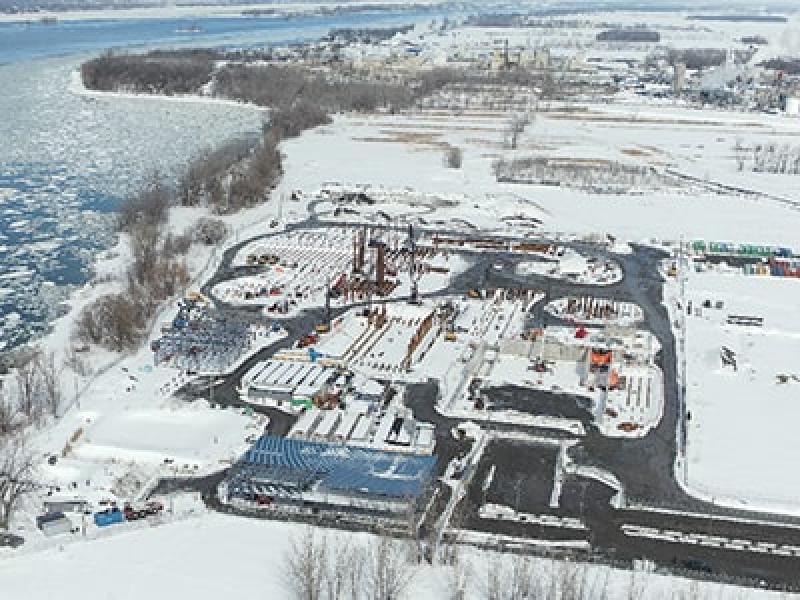
The Canada Infrastructure Bank (CIB) has announced a $277-million loan to support Varennes Carbon Recycling’s $1.2-billion Quebec biorefinery and Canada’s largest electrolyzer.
The announcement is the second major development in recent days for the complex, which is already under construction. Varennes also announced Cummins Inc. will supply the 90-megawatt electrolyzer for the facility.
The Varennes Carbon Recycling (VCR) biorefinery will produce biofuels from non-recyclable waste and residual biomass.
“We are pleased with the support of the CIB to Varennes Carbon Recycling that now combines the electrolyzer with the biorefinery into one single project. CIB's participation enables this first-of-a-kind, fully commercial project, based on Enerkem's waste-to-methanol technology platform,” Dominique Boies, Enerkem’s CEO, said in the announcement.
The CIB loan is its first in the sector since its mandate was expanded in the 2022 Canadian federal budget.
“The Canada Infrastructure Bank is pleased to have acted quickly on its expanded role to support transformational efforts to accelerate Canada's transition to a low-carbon economy,” Ehren Cory, CEO of Canada Infrastructure Bank, said in the release.
“Converting waste and residual biomass into clean hydrogen is the CIB's latest effort helping the country reach net zero by 2050 and represents its first investment in low-carbon fuels.”
VCR is a joint venture involving Montreal-headquartered Enerkem Inc., Shell plc, Suncor Energy and methanol producer Proman. The biorefinery will be powered by Enerkem’s waste-to-methanol platform and is expected to be operational by 2025.
The facility is expected to turn 200,000 tonnes of non-recyclable waste and residual forest biomass into nearly 130 million litres of biofuels per year.
The project was announced in 2020.
The electrolyzer system itself will be comprised of four proton membrane exchange (PEM) HyLYZER-5000s, the largest electrolyzers made by Accelera, a business segment of Cummins. Each HyLYZER-5000 utilizes 25 megawatts of electricity and can produce up to 10 tonnes of hydrogen and 250 tonnes of oxygen per day.
“The addition of hydrogen essentially allows, in the Enerkem methanol loop, to recoup a lot of that CO2 (carbon dioxide) by mixing it with hydrogen across catalysts, and to reclaim that carbon that would normally be exhausted as carbon dioxide, back into your methanol," Cole Henderson, VCR’s general manager and portfolio engineering director, said.
Cummins and VCR
Cummins (CMI-N), headquartered in Columbus, Ind., is a broad provider of power solutions. In 2022, it earned $2.2 billion on sales of $28.1 billion. The company launched Accelera earlier this month.
An electrolyzer splits water into hydrogen and oxygen. The hydrogen can be stored as a compressed gas or liquid and used as a clean power source to help decarbonize a variety of hard-to-abate sectors. The VCR facility will use both the renewable hydrogen and oxygen to recycle carbon and hydrogen from the waste materials.
“So we actually consume all of the oxygen in the gasifier, and then consume the hydrogen in the methanol, in order to increase the capture of the carbon molecule,” Henderson said.
In a statement, Accelera president Amy Davis explained VCR will host the first installation of the HyLZER-5000, and the first time its electrolyzers will power biofuel production. The HyLZER also generates five times more hydrogen than any of Accelera’s PEM electrolyzers.
A highlight for VCR in selecting Cummins was its use of a PEM electrolyzer.
“The ability to have it produce the hydrogen and the oxygen at higher pressures meant the downstream components of the plant are quite simple. The less moving parts you have, the less parts that will break,” Henderson said. “So there's an availability
advantage of the PEM technology in our application. Another part of that is just looking at the overall total cost of ownership.”
VCR plans to have the electrolyzers online around the same time as the facility begins commissioning in 2025.
Varennes Carbon Recycling
Enerkem was founded in 2000 by professor emeritus Esteban Chornet at the Université of Sherbrooke in Quebec. It was the first company to produce renewable methanol and ethanol from non-recyclable, non-compostable municipal solid waste at commercial scale.
The company’s website estimates annual economic benefits of $85 million for Quebec from this project.
Methanol can be used as a fuel, or converted into bio-gasoline. Because it contains carbon and hydrogen, it can be used in a variety of other ways, with Henderson giving pharmaceuticals as an example.
The company also mentions the use of ‘circular chemicals.’ Henderson explained that if the produced methanol were to be used in cookstoves, the carbon released would be reabsorbed by nearby trees.
“Fundamentally, if that cookstove was within 200 kilometres of the facility, it would then be CO2 that could be in a tree 75 years from now (and) was reused as feedstock,” Henderson said.
“So the idea behind that circular economy is simply those carbons go around in a circle, and there's no net addition of carbon to our environment."
“But if you look at municipal solid waste, which is made up of things like cardboard, or organic materials such as food waste, it all follows that very similar type of pathway.”
According to Henderson, 50 per cent of the facility's feedstock will be forestry biomass.
Some will also come from municipal solid waste. He also explained that around 170,000 tonnes of carbon dioxide equivalent would be avoided annually through the waste conversion.
Over the facility’s 25-year lifespan, this would equal 4.25 million tonnes.
Once it is complete, VCR plans to sell the biofuels wherever it can.
“It's really about working with the Canadian government and other jurisdictions that are setting policies that are out there. They need the market for those types of products,” Henderson said.










